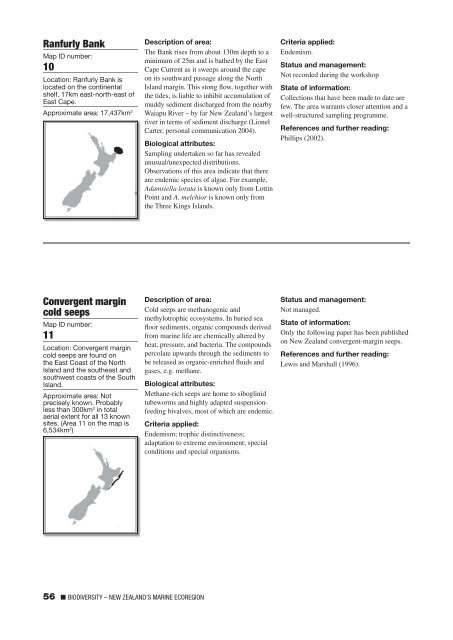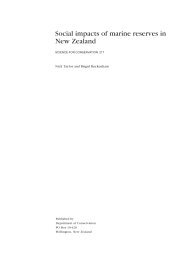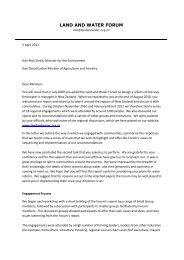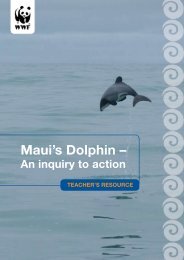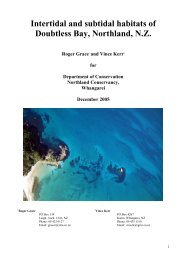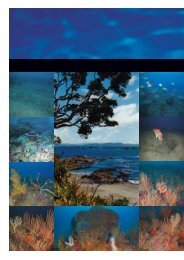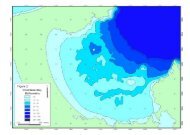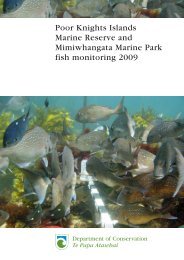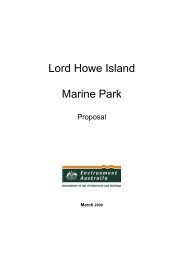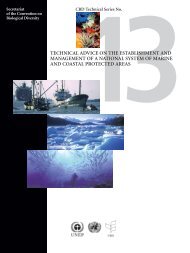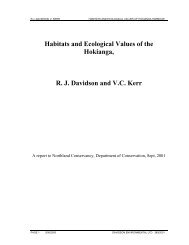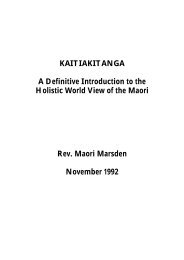WWF Shining a spotlight on the biodiversity of ... - MarineNZ.org.nz
WWF Shining a spotlight on the biodiversity of ... - MarineNZ.org.nz
WWF Shining a spotlight on the biodiversity of ... - MarineNZ.org.nz
Create successful ePaper yourself
Turn your PDF publications into a flip-book with our unique Google optimized e-Paper software.
Ranfurly Bank<br />
Map ID number:<br />
10<br />
Locati<strong>on</strong>: Ranfurly Bank is<br />
located <strong>on</strong> <strong>the</strong> c<strong>on</strong>tinental<br />
shelf, 17km east-north-east <strong>of</strong><br />
East Cape.<br />
Approximate area: 17,437km 2<br />
Descripti<strong>on</strong> <strong>of</strong> area:<br />
The Bank rises from about 130m depth to a<br />
minimum <strong>of</strong> 25m and is ba<strong>the</strong>d by <strong>the</strong> East<br />
Cape Current as it sweeps around <strong>the</strong> cape<br />
<strong>on</strong> its southward passage al<strong>on</strong>g <strong>the</strong> North<br />
Island margin. This st<strong>on</strong>g flow, toge<strong>the</strong>r with<br />
<strong>the</strong> tides, is liable to inhibit accumulati<strong>on</strong> <strong>of</strong><br />
muddy sediment discharged from <strong>the</strong> nearby<br />
Waiapu River – by far New Zealand’s largest<br />
river in terms <strong>of</strong> sediment discharge (Li<strong>on</strong>el<br />
Carter, pers<strong>on</strong>al communicati<strong>on</strong> 2004).<br />
Biological attributes:<br />
Sampling undertaken so far has revealed<br />
unusual/unexpected distributi<strong>on</strong>s.<br />
Observati<strong>on</strong>s <strong>of</strong> this area indicate that <strong>the</strong>re<br />
are endemic species <strong>of</strong> algae. For example,<br />
Adamsiella lorata is known <strong>on</strong>ly from Lottin<br />
Point and A. melchior is known <strong>on</strong>ly from<br />
<strong>the</strong> Three Kings Islands.<br />
Criteria applied:<br />
Endemism.<br />
Status and management:<br />
Not recorded during <strong>the</strong> workshop<br />
State <strong>of</strong> informati<strong>on</strong>:<br />
Collecti<strong>on</strong>s that have been made to date are<br />
few. The area warrants closer attenti<strong>on</strong> and a<br />
well-structured sampling programme.<br />
References and fur<strong>the</strong>r reading:<br />
Phillips (2002).<br />
C<strong>on</strong>vergent margin<br />
cold seeps<br />
Map ID number:<br />
11<br />
Locati<strong>on</strong>: C<strong>on</strong>vergent margin<br />
cold seeps are found <strong>on</strong><br />
<strong>the</strong> East Coast <strong>of</strong> <strong>the</strong> North<br />
Island and <strong>the</strong> sou<strong>the</strong>ast and<br />
southwest coasts <strong>of</strong> <strong>the</strong> South<br />
Island.<br />
Approximate area: Not<br />
precisely known. Probably<br />
less than 300km 2 in total<br />
aerial extent for all 13 known<br />
sites. (Area 11 <strong>on</strong> <strong>the</strong> map is<br />
6,534km 2 )<br />
Descripti<strong>on</strong> <strong>of</strong> area:<br />
Cold seeps are methanogenic and<br />
methylotrophic ecosystems. In buried sea<br />
floor sediments, <strong>org</strong>anic compounds derived<br />
from marine life are chemically altered by<br />
heat, pressure, and bacteria. The compounds<br />
percolate upwards through <strong>the</strong> sediments to<br />
be released as <strong>org</strong>anic-enriched fluids and<br />
gases, e.g. methane.<br />
Biological attributes:<br />
Methane-rich seeps are home to siboglinid<br />
tubeworms and highly adapted suspensi<strong>on</strong>feeding<br />
bivalves, most <strong>of</strong> which are endemic.<br />
Criteria applied:<br />
Endemism; trophic distinctiveness;<br />
adaptati<strong>on</strong> to extreme envir<strong>on</strong>ment; special<br />
c<strong>on</strong>diti<strong>on</strong>s and special <strong>org</strong>anisms.<br />
Status and management:<br />
Not managed.<br />
State <strong>of</strong> informati<strong>on</strong>:<br />
Only <strong>the</strong> following paper has been published<br />
<strong>on</strong> New Zealand c<strong>on</strong>vergent-margin seeps.<br />
References and fur<strong>the</strong>r reading:<br />
Lewis and Marshall (1996).<br />
56 ■ BIODIVERSITY – NEW ZEALAND’S MARINE ECOREGION


